Журнальный клуб Интелрос » Joint Force Quarterly » №77, 2015
The U.S. changed the security landscape in the 1970s and 1980s with networked precision strike, stealth, and surveillance for conventional forces. We will identify a third offset strategy that puts the competitive advantage firmly in the hands of American power projection over the coming decades.2
Developing game-changing technology during periods of declining budgets requires two main ingredients. The first is building a culture of innovation with scientists, engineers, and midgrade military officers that fosters thinking about old problems in new ways. The second, most important ingredient is having senior leaders and bureaucrats who open the way for innovation through support of experimentation and prototyping. This article outlines two historical examples of successful military innovation efforts, the current challenges facing the Department of Defense (DOD), including the complexity of the national security environment, the decline in research, development, test, and evaluation (RDT&E) budgets, and finally, in spite of these challenges, the DOD strategy for developing innovative military capabilities moving forward.
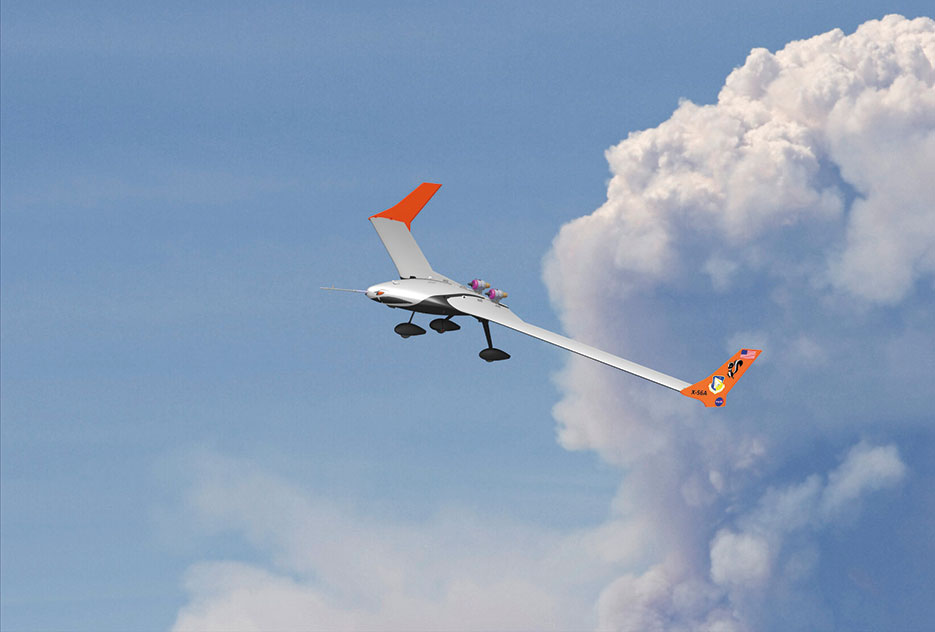
Innovative, modular unmanned flight research vehicle X-56A allows investigation of active flutter suppression and gust load alleviation technology (U.S. Air Force)
DOD has a rich history of innovation through prototyping for the development of future military capability. Two of the best historical examples, tank prototyping and X-planes, illustrate different characteristics of what makes prototyping successful. Tank prototyping was driven by the imperative to find an alternative to embedded trench warfare tactics used in World War I. These efforts emerged from midgrade military officers driven by ideas for new tactics and employment techniques who challenged industry to develop technology that would facilitate their ideas. X-planes were driven by timely application of the development of turbine jet engines by innovative scientists and engineers working with military personnel. The process involved nearly continuous insertion of new technology operating inside an established paradigm shared by DOD and industry. This collaboration allowed new tactics and employment techniques to be developed based on the information learned through the development.
Tank Prototyping and Experimentation. A well-researched and documented example of capability prototyping and experimentation is the integration of tanks into the mechanized combat arms of the U.S. Army from World War I to the beginning of World War II. According to Robert Cameron, the “Mechanized Force emerged as a tactical laboratory intended to determine the optimal organization and doctrine for a combat unit built around the tank.”3 As profound a statement as this sounds, tank development during this period was met with every possible level of resistance, hamstrung by limited budgets and overshadowed by an enormous amount of parochialism. A brief but deeper look at the emergence of tank technology during and between World War I and World War II also reveals the efficacy of capability prototyping that resulted in spite of the obstacles and resulted in victory over Axis forces in World War II and later the emergence of the most sophisticated mechanized force the world has ever seen.
In early World War I, the British and French had each built, and were both using, tanks.4 The British used tanks to overcome obstacles to the infantry whereas the French used tanks as fire support to complement the firepower of the infantry.5 The U.S. Army saw merit in both uses but had no documented requirements or plans to build any until after the war. They partnered with the British and French armies to learn about the new tank technology without committing to production of any American variants.
In February 1918, General John J. Pershing activated the Light Tank School in Bourg, France, and appointed a young officer, George S. Patton, to lead the school and experiment with tactics, techniques, and procedures (TTPs).6 Near the end of the war in 1918, another young officer named Dwight D. Eisenhower was sent to Camp Meade, Maryland, to plan for the creation of the first tank battalion.7 The collaboration and passion for tank warfare between these two icons would last throughout their careers and result in the dominance of Allied tank warfare in Europe and North Africa in World War II. Early on, though, Patton and Eisenhower argued against conventional TTP wisdom and for using tanks as a separate arm of the fighting force not merely in support of the infantry. They opined that the lack of enthusiasm for tanks was due to “inadequate knowledge of [their] use and potential.”8 In addition to developing and experimenting with tanks at Camp Meade, Eisenhower and Patton did a great deal of writing about tank warfare and tank design in the Infantry Journal—nearly always going against the grain of Army leadership.9
After World War I, Army leadership, supported by Congress, disbanded the small tank units being used for experimentation and subordinated the few tanks that were left to the infantry. Eisenhower and Patton continued to experiment with tanks and develop doctrine and TTPs to use them as a separate combat arm. When the research and development funding was cut to nearly zero, however, both officers were reassigned and the development of tanks stagnated.10 Continued funding austerity only allowed one tank prototype to be built between 1925 and 1931.11
In the shadow of the edict set forth by Congress in the 1920 National Defense Act, which subordinated tanks to the infantry, there was increasing agreement that tank development needed to continue in spite of the bureaucratic maze set up by the War Department and Congress. Brigadier General Samuel Rockenbach, formerly Chief of the Tank Corps and Commandant of the Tank School, saw promise in the ideas of Eisenhower and Patton, so he kept tank development and experimentation alive.12 But it was not until after a trip to visit with the British army’s Experimental Mechanized Force in 1927 that Secretary of War Dwight Davis finally established the American Experimental Mechanized Force at Camp Meade in 1928.13
In 1930, when Douglas MacArthur was made Chief of Staff of the Army, he began an effort to mechanize the force with a particular emphasis on tanks. He also supported Patton and Eisenhower’s ideas about offensive uses of tanks and sponsored some limited experimentation efforts to keep the momentum going. Just prior to World War II, Eisenhower became a trainer and author of the winning battle plan for the newly established Louisiana Maneuvers, which were14
pre-World War II General Headquarters exercises initiated by General George C. Marshall to prepare the Army for World War II. They featured the field-testing of new doctrinal and organizational concepts, and of new equipment and schemes for its employment. They provided practical, hands-on experience in leading troops in the field with the most modern of configurations. They force-fed change to an institution that otherwise was only beginning to shake off its prewar somnolence.15
The Louisiana Maneuvers during 1940–1941 were intended to change a peacetime mentality and prepare the Army for the impending global conflict.16 Marshall was determined to use experimentation to design a fighting force that had expertly trained Soldiers following sound doctrine in ways that fostered “innovation and growth in extraordinary ways.”17
Fifty years later, General Gordon R. Sullivan, Army Chief of Staff, came into office “confronted with a number of conditions that greatly taxed the Army: the end of the Cold War; large, congressionally mandated reductions in Army funding; concomitantly large reductions in the size of the force; and a series of contingency deployments.”18 He took a lesson from Marshall and established the modern Louisiana Maneuvers (LAM) to ready a force that could fight in the 21st century with agile and innovative capabilities. His modern version of Marshall’s idea was based on “iterative experimentation that would make extensive use of computer-based simulations to test proposed doctrine, procedures, organizations, and equipment.”19 Some of the most important capabilities that came out of LAM, including Total Asset Visibility, Battlefield Digitization, and Owning the Night, are ones that have paid dividends many times over.20
Lessons learned from the introduction of tank technology during and between World War I and World War II and the larger experimentation efforts of both the original Louisiana Maneuvers and the modern Louisiana Maneuvers after the first Gulf War are applicable to the situation we face today following many years of war in Iraq and Afghanistan. The circumstances in both historical cases and in our current situation are the same: declining defense budgets, shrinking force levels, limited research and development funding, and doctrinal and political debates about the character of warfare in the future.
The first lesson to be learned is that with limited resources, prototyping and experimentation are good investments. A second lesson is that doctrine based on past wars is not usually valuable when preparing for future conflicts. The final lesson is that there are always young men and women such as Eisenhower and Patton in our ranks who have creativity in their DNA. They should be allowed to share it within a system that supports agility and innovation.
Evolution of X-Plane Prototyping and Military Aviation. An equally well-known series of prototypes in military history are the X-planes. In a brochure specifically published to share the results of the first X-plane prototype with industry, the purpose for the research was explained as follows:
The limited knowledge of aerodynamics and flight performance in the transonic and supersonic speed ranges possessed in 1944 dictated the initiation of research projects which would increase our meager fund of fundamental and factual information in this field of learning. A comprehensive program for the development of purely research aircraft was laid down and a maximum effort was directed toward its immediate implementation (emphasis added).21
A purpose statement like this could be written for any of the technological challenges we face today. The key elements are limited knowledge of the technology, clear mandate, and understanding that the primary intent is for research.
In response to its stated purpose, the X-1 program, which lasted from 1946 to 1958, developed seven airframes, flew 236 test flights, and experienced only three major accidents. The accomplishments of the X-1 series were not only noteworthy at the time but also provided an important array of technologies that can be found in nearly all high performance military aircraft today. In addition to being the first aircraft to break the sound barrier in level flight, the X-1 series of prototypes set a baseline of high-speed and high-altitude testing and proved the aerodynamic viability of thin wing sections.22
During the 1950s, 17 other X-plane projects were launched to test everything from tail-less airframes to vertical takeoff and landing (VTOL). By way of illustration, the X-14 series tested VTOL technology from 1957 to 1981 and paved the way for the X-22 series (1966–1984) that eventually developed the dual-tandem ducted propeller configuration found in the V-22 aircraft of today. An example of X-plane prototyping during this period that did not result in production or even a testable prototype was the X-6 (1955–1957), which was designed to test the feasibility of using nuclear propulsion in an aircraft.23
During the 1960s, seven more X-plane prototyping projects produced testable aircraft. Although many other technologies were matured during this period, two notable programs were the X-23A (unmanned) that tested ablative materials for hypersonic reentry vehicles used in the space program and the X-26 series that made significant contributions to stealth designs that would later be produced in some of the most sophisticated reconnaissance aircraft ever produced. The 1970s only produced one X-plane program, whose unique contribution was that it was a home-built aircraft designed to explore the usefulness of small seaplanes for civil police patrol in Southeast Asia. Like the decade that preceded it, the 1980s produced only one X-plane, which is notable because it introduced the forward-swept wing design, advanced composites, and other aerodynamic advances that allowed it to fly supersonically.
These developments paved the way for all high-performance fighter aircraft in production since that time. The final decade of the 20th century also produced only one full-sized X-plane, the X-31 (1990–1995) Extremely Short Takeoff and Landing thrust vectoring super maneuverability test bed, along with three other scale models that were used to explore other design modifications.
In the first decade and a half of the 21st century, activity in the X-plane community increased with X-32 to X-56 series producing unmanned combat air vehicle demonstrators, compound helicopter Vectored Thrust Ducted Propeller technology, and a hypersonic scramjet. Several of these projects were tied directly to the Joint Strike Fighter and F-22 aircraft development programs.
When all 56 X-plane programs are plotted on a chart from 1940 to 2012, several findings emerge. First, it takes several decades of prototyping for some technologies to end up in a fielded aircraft. Second, during periods of increased war spending (for example, the Cold War and Iraq and Afghanistan wars), fewer prototypes are built. Finally, X-plane programs in recent decades are more aligned with program development than the “purely research” aims of the X-1 program.24
X-plane prototyping highlights two potential benefits that can inform the offset strategy being employed in the Defense Innovation Initiative. The first and perhaps most compelling benefit of using prototyping for future capability development during budget uncertainty is that it provides a way to keep pace with technology without having to commit large sums of funding to traditional acquisition programs. The second benefit of prototyping as a cost-sharing mechanism is that it provides a way to partner with industry in an environment that offers open exchange of information.

X-2 rocket plane dropped from B-50 Superfortress mothership in mid-1950s (NASA)
As evidenced by the tank and X-plane examples, development of innovative warfighting capability in the 20th century was driven by the need to obtain and maintain superior technology-based capabilities. From low observables to space to precision munitions, the United States has maintained a significant military advantage over its adversaries through innovative technologies. Current trends in global security combined with political and financial pressures, however, are forcing DOD to reexamine how it develops operational capability in a cumbersome acquisition process that developed during the Cold War. The combined pressures of complex threats and significant defense spending reductions are compelling DOD to make bold strategic choices in its approach to developing capability that maintains technical superiority.
In his February 24, 2014, testimony on the fiscal year 2015 budget, Defense Secretary Chuck Hagel concluded, “we are entering an era where American dominance on the seas, in the skies, and in space can no longer be taken for granted.”25 Deputy Secretary of Defense Robert Work added, “the United States has never, since the end of World War II, tried to match our potential adversaries tank for tank, airplane for airplane, person for person, missile for missile. We have always sought an offset.”26 The new offset strategy is based on encouraging a culture of innovation in our people and our business practices, that is, the “creation of a long-range research and development program” that produces breakthrough technology, as well as the “reinvigoration of wargaming” and prototyping that develops new operational concepts.27 Two significant challenges to the strategy, however, are the complexity of the national security environment and the increasing fiscal pressures on the DOD budget in general and more specifically the RDT&E budget.
Complexity of the National Security Environment. Complexity of the national security environment is defined by increasing challenges from nation-states and nonstate actors who challenge the security of the United States and its allies in the domains of land, sea, air, space, and cyberspace. This confluence of challenges includes:
Other nations are already taking advantage of the increasing pace of technology development by targeting our warfighting enablers and attacking the fragility of our information networks allowing leakages of critical information.
As we emerge from years of war in Iraq and Afghanistan, the geopolitical landscape in the Middle East continues to change, with unrest in Egypt, chemical weapons concerns in Syria, and the persistent nuclear ambitions of Iran leaving the overall situation unstable at best. Additionally, threats from the continuing spread of terrorism across continents continue to challenge the security of not only the Nation but also partner nations and the relationships we are building with our partners. Finally, other nations’ development of advanced military capability is closing the capability gap with nations that were well ahead technologically in the past. These complex and growing threats are making strategic choices more difficult.
Fiscal Pressures on Research and Development. Declining budgets are also changing the way we think about developing warfighting capability. Deputy Defense Secretary Work recently made it clear that future budgets will impact capability development:
The national security of the United States is not well served by sequestration. We just have to keep pointing out that if you want a budget-driven strategy, go to sequestration. If you want us to have a strategy that’s good for the nation, then go more with the president’s budget.28
A common indicator of concern in the commercial and Federal Government R&D sectors is rate of growth of R&D compared to the per capita growth of gross domestic product (GDP). The National Science Foundation (NSF) tracks this metric, among many others, and found that from 1989 to 2009 Federal spending for R&D grew just 1.3 percent annually while GDP rose 2.4 percent annually.29 More recent data from the NSF also show an interesting trend when Federal Government R&D is compared to business R&D. According to the National Science Board Report for 2014, “Most of U.S. basic research is conducted at universities and colleges and funded by the federal government. However, the largest share of U.S. total R&D is development, which is largely performed by the business sector. The business sector also performs the majority of applied research.”30
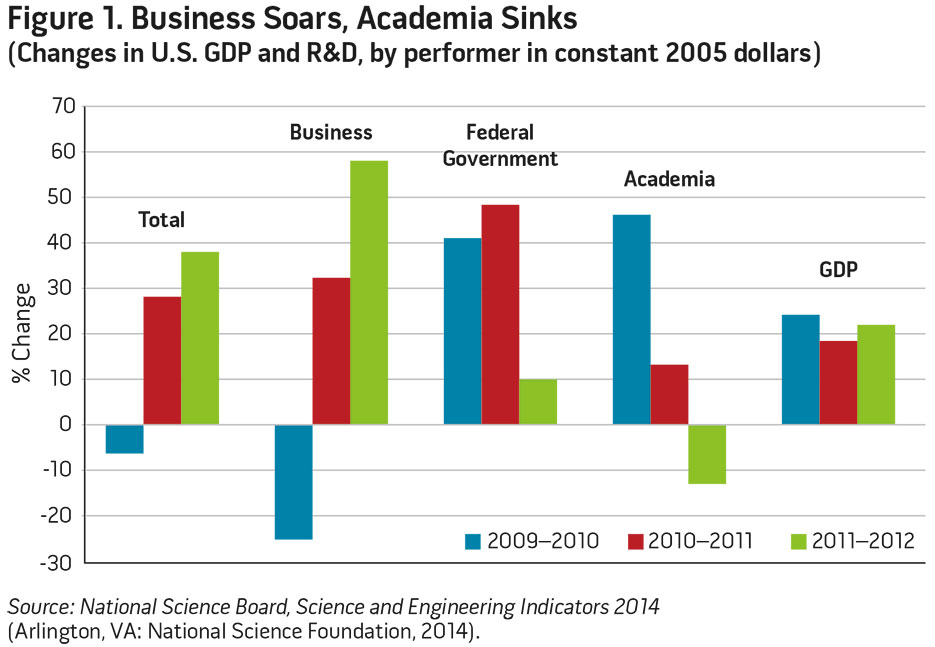
Figure 1 illustrates clearly that from 2009 to 2012, business R&D made a dramatic turnaround while Federal Government R&D was in decline. Of concern to DOD is the symbiotic dependence of academic researchers on Federal Government funding and the effect of the reductions in 2011–2012 as noted by the National Science Board. This implies that any DOD solution provider should review industry R&D first and use what industry has already funded, modified to defense needs as appropriate.
The good news is that the 5 percent boost in national R&D spending in 2011 to $428 billion and a jump of 5.7 percent to $452 billion for 2012 are well ahead of the 4 percent growth in the GDP in each of those years.31 This trend suggests a return to historical patterns in which the Nation’s total R&D investment grows at a faster rate than GDP.
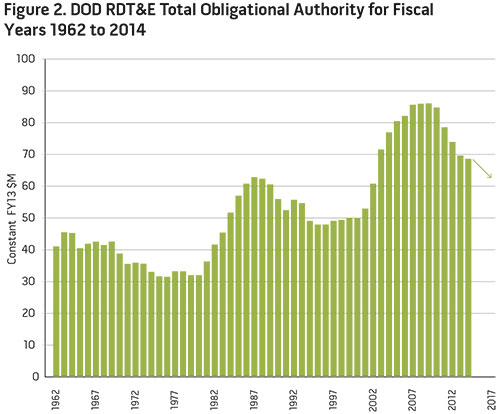
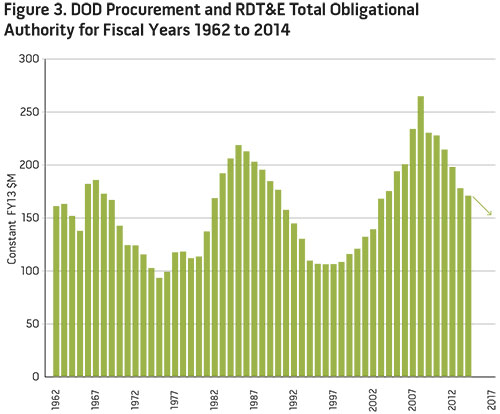
DOD has traditionally relied on its RDT&E budget to generate new capability to ensure military superiority. Figure 2 illustrates that RDT&E accounts are contracting sharply since their peak in fiscal year 2009. Procurement budgets are used to complete the development of new capability through systems engineering and manufacturing of weapons systems that exploit the capabilities that have been developed through the RDT&E phases. Figure 3 shows that when the procurement accounts used for new systems development and modernization of current systems are added to RDT&E funding, the calculus of fiscal constraint does not change; in fact, it exacerbates the severity of the situation.
Implications for the current fiscal environment cannot be understated. The reduction in RDT&E accounts will not only cut the investment in new science and technology but will also result in a decline in scientists and engineers working on DOD problems. This decline will result in less national security technical capacity. Pressures on procurement budgets will lead to fewer new start efforts and increased focus on preserving and evolving current capacities. Without strong management, there is a potential for two serious negative impacts. First, there will be a limited appetite for risk that biases decisionmakers against the development and insertion of new technologies. Risk aversion will reduce the pace of technological advance in U.S. programs and permit our global competitors to take advantage of the increasing pace of technology. The second impact of falling RDT&E and procurement budgets will be a reduction of industrial design capability as infrequent new design efforts may place cutting-edge design capability at risk. It will be difficult to regenerate these defense-specific design capabilities at a later date when they might be required.
The DOD strategy, as stated in Sustaining U.S. Global Leadership: Priorities for 21st Century Defense, is to “encourage a culture of change and be prudent with its ‘seed corn,’ balancing reductions necessitated by resource pressures with the imperative to sustain key streams of innovation that may provide significant long term payoffs.”32 In light of a complex set of threats and declining resources for RDT&E and procurement, the challenge faced by DOD is how to sustain and grow investment in future technologies and systems concepts in a period of declining resources.
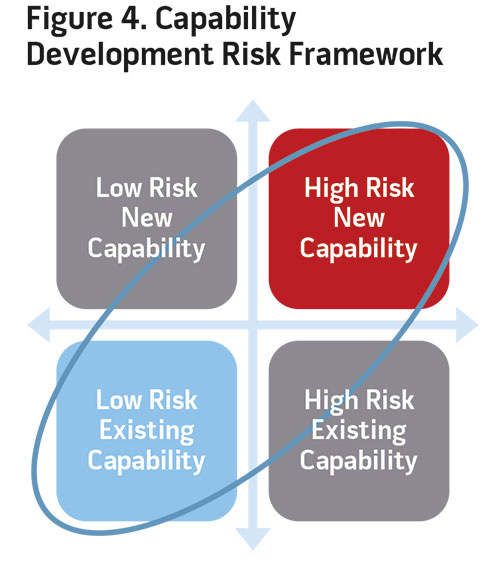
Strategic guidance for how to approach this challenge is contained in the companion document to Sustaining U.S. Global Leadership. The Defense Budget Priorities and Choices guidance outlines an approach to achieving significant savings over the next 5 years that will result in a joint force that may be “smaller and leaner” but “will remain agile, flexible, ready, innovative, and technologically advanced.”33 Regarding the protection of new capabilities and investments, the guidance directs “increasing funding for a few capabilities while protecting others at existing levels or making comparatively modest reductions” by making “deeper offsetting reductions in areas of lesser priority.”34 The focus of capability development based on risk is illustrated in figure 4.
Capability development under this strategy focuses on two opposite applications of new technology: low-risk applications of new technology that enhance current capability, and high-risk applications of new technology that result in new capability. Developing low-risk applications of new technology to enhance current capability is a path well worn in DOD. We have a rich history of incremental improvement. The challenge at hand, when faced with declining budgets and technologically sophisticated adversaries, is how to protect the “seed corn” or emerging science and technology that could yield breakthroughs in the ways we fight and win wars in the future.
A recent report compiled by the World Technology Evaluation Center, funded and supported by participants from the NSF, National Institutes for Health, National Aeronautics and Space Administration, Environmental Protection Agency, Office of Naval Research, and Department of Agriculture, suggests a useful framework for thinking about the complexities of how to capture emerging science and innovation in the 21st century.35 The report uses a convergence-divergence cycle for capturing megatrends in science and engineering. The report defines convergence as “the escalating and transformative interaction among seemingly distinct scientific disciplines, technologies, communities, and domains of human activity to achieve mutual compatibility, synergism, and integration, and through this process to create added value and branch out into emerging areas to meet shared goals.”36 In the convergence phases of the cycle, a creative phase captures the synergism between multidisciplinary domains and integrates them during the fusion phase. In the divergence phases, the fused knowledge is integrated through systems development in innovative new ways, culminating in the outcome phase where added value applications are tested and deployed.37
The report notes that cellular technology, or more specifically the smartphone, provides perhaps the best example for understanding the cycle of convergence and divergence. Combining new knowledge in materials science, nanotechnology, cognitive science, and human-machine interface technologies gave us the cell phone platform approximately a decade ago, but the more recent explosion of applications was fueled by the divergence phases of innovation and outcomes that use the technology in ways that have “profound implications for and secondary impacts on areas as diverse as national security, education, and cognitive science.”38
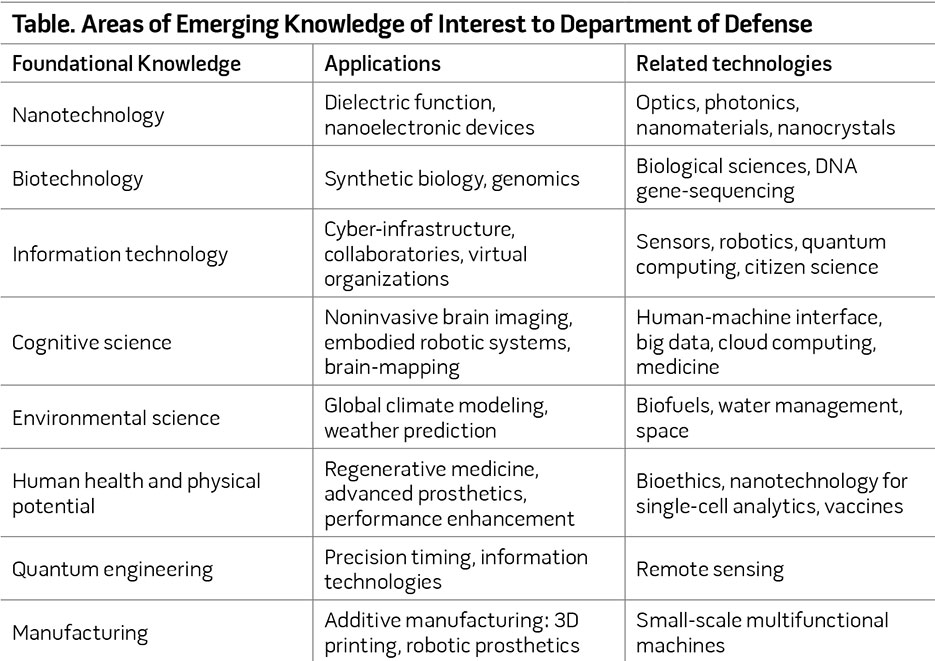
Convergence of Scientific Knowledge.The table summarizes the findings of the report titled Convergence of Knowledge, Technology, and Society: Beyond Convergence of Nano-Bio-Info-Cognitive Technologies regarding emerging scientific knowledge that could be of interest to DOD.39
Thinking in terms of this framework of convergence and divergence, DOD intends to maintain current levels of RDT&E investment and increase investment in warfighting enablers through prototyping for agility and innovation. Convergence will be primarily incubated in the science and technology community while increased commitment toward divergence will be promoted in the engineering, testing, and acquisition communities. Both will require a culture of change and innovation.
Using Capability Prototyping to Maintain Technical Superiority. In a recent meeting of senior DOD leadership, the Assistant Secretary of Defense for Acquisition and the Acting Assistant Secretary of Defense for Research and Engineering teamed up to propose an agility and innovation effort aimed at the development of capability through the expanded use of developmental and operational prototypes. Developmental prototypes demonstrate a capability without worrying about operational factors. Operational prototypes demonstrate a capability while taking into account sustainability, manufacturability, and reliability. The combined efforts of the research and engineering community and acquisition community aim to increase investment in prototyping that will build enabling capabilities such as enhancements to the electromagnetic spectrum and alternative options in space that enhance more conventional programs. Given the direction to move forward, a pilot effort targeted at streamlining the process for proposing, evaluating, and executing agile and innovative prototypes efforts began last year within existing programs of record.
Today’s Prototyping for Agility and Innovation. Key to encouraging a culture of change as outlined in Sustaining U.S. Global Leadership and the Long Range Research and Development Planning Program is a commitment to “encourage innovation in concepts of operation.”40 In DOD, concepts of operation are developed through experimentation typically combining the use of existing systems and new technology inserted to either existing systems or in the form of prototypes. Military users can exercise prototypes to evaluate opportunity afforded by innovative platforms, systems, and weapons to explore the tactical and strategic advantages offered by new technologies. The advantage of full- or near-full-scale prototypes is their availability to participate in exercises or contingency operations permitting Service leaders to assess their use in an operational context. Experimenting with prototypes in operational environments will provide insights that inform future requirements and provide opportunities to consider systems approaches that represent significant departures from current material solutions. We can leverage developmental and operational prototyping to:
There are three elements of our agile and innovative prototyping strategy:
Key characteristics of an effective prototyping program are the ability to remain rapid and agile, visible and public, and fair and open. The ability to be rapid and agile will be facilitated by design cycles (inside of 2 years) that are short enough to permit rapid and continuous technological advance permitting U.S. capability options to grow faster than a potential opponents cycle time. To ensure visibility, advanced prototyping demonstrations will be unclassified to the greatest extent possible. Demonstrated capability will serve to modify potential adversary’s behavior by demonstrating U.S. capabilities and imposing costs on an adversary to develop and deploy counters to U.S. potential capabilities. To remain fair and open, DOD investments in prototyping will create intellectual property that should be shared with largest possible U.S. community. While the government will retain intellectual property rights to technologies developed under prototyping efforts, the knowledge and experience developed will be shared across the defense industrial base. Our desire is not to have prototyping efforts overly influence competitive field for future acquisitions. Prototyping serves as a means for DOD to maintain and technologically refresh critical defense industrial base design and manufacturing capabilities during new start design and production lulls. Delivery of full-scale (or near-full-scale) prototypes can exercise production-representative manufacturing capabilities and supports capital investment in maintaining state-of-the-art design and fabrication capability.
Prototyping also inspires innovative designers and engineers. Providing a conduit to address critical DOD challenges through prototyping should attract the best and brightest in the defense industrial base workforce. Prototyping efforts should also aid in recruiting young scientists and engineers and serve as an important platform to emphasize the attractiveness of science, technology, engineering, and mathematics education. Advanced prototyping efforts also serve as a critical development tool for recruiting and retaining technical leaders already in DOD—these are the programs that careers are built on and inspire others to pursue technical excellence within government service. Finally, public interest in advanced technology prototyping will reflect well on DOD technical capabilities and acquisition workforce.
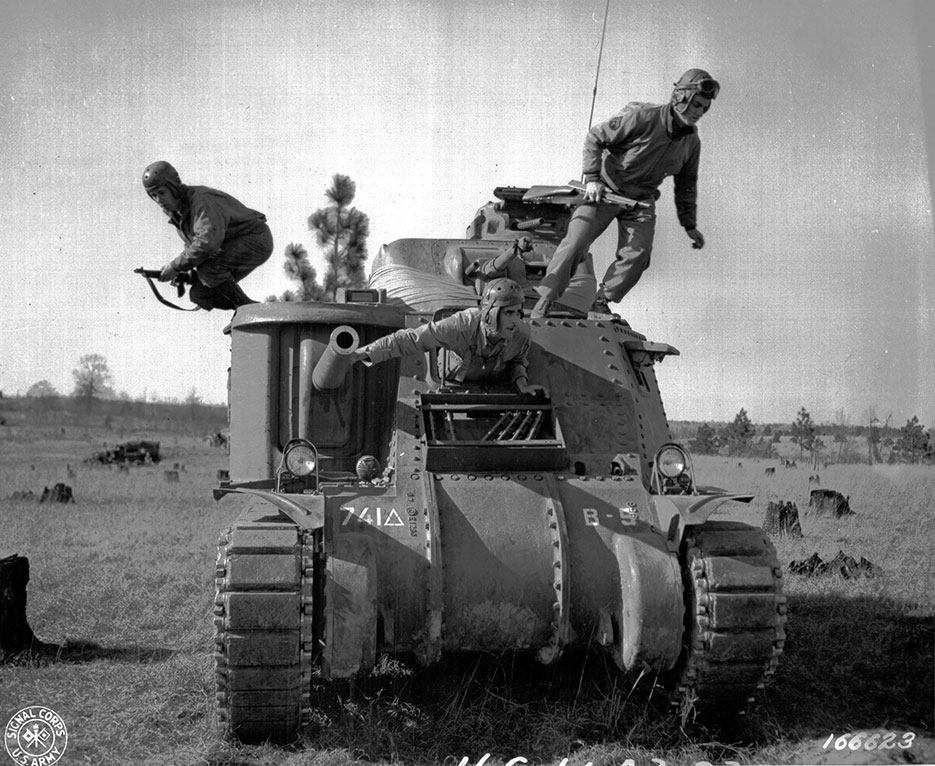
Soldiers abandon disabled M-3 tank during Third Army Louisiana Maneuvers at Camp Polk in 1943 (Signal Corps/Calvano)
In a fiscal climate where DOD will be constrained in its pursuit of modernization-focused new starts, developmental and operational prototyping can serve as the means to advance the current state of the possible, exercise cutting-edge design teams, maintain technical advantage over potential future adversaries, and permit operational users to gain insight into future technology-enabled strategies and tactics. In a fiscally constrained environment, it will be critical to avoid thinking of advanced prototypes as lead systems for follow-on procurement programs. Instead, prototyping programs might only be pursued to the point where they provide a realistic exercise of a design concept or its associated manufacturing capabilities. These programs might also demonstrate potential solutions to emerging technological and operational challenges.
To protect “seed corn,” DOD must stay abreast of scientific trends and emerging technologies. New discoveries in emerging technologies such as embodied robotic systems and 3D printing could mean unprecedented breakthroughs in defensive and offensive capabilities. Using vision-inspired basic research leads to emerging uses beyond known applications and results in new ideas and inventions that can be nurtured through developmental prototyping. Using a convergence-divergence paradigm, DOD is embarking on a two-pronged, risk-based strategy that uses our resources (funding, facilitates, and people) in the most efficient and effective means to support the defense of the Nation. Key to this new strategy and supporting the convergence-divergence evolutionary process is our increased emphasis on developmental and operational prototyping.
Whether prototyping is used to develop new and innovative capability or improve existing capability, the efficacy of using it during a period of constrained resources and geopolitical uncertainty is sure. Taking the art of the possible and turning it into the science of the doable is a research and development agenda that is worth pursuing. The success of our efforts, however, will depend on building a culture of change, innovation, and collaboration. The final and most important ingredient will be the intellectual curiosity and creativity of our people. JFQ